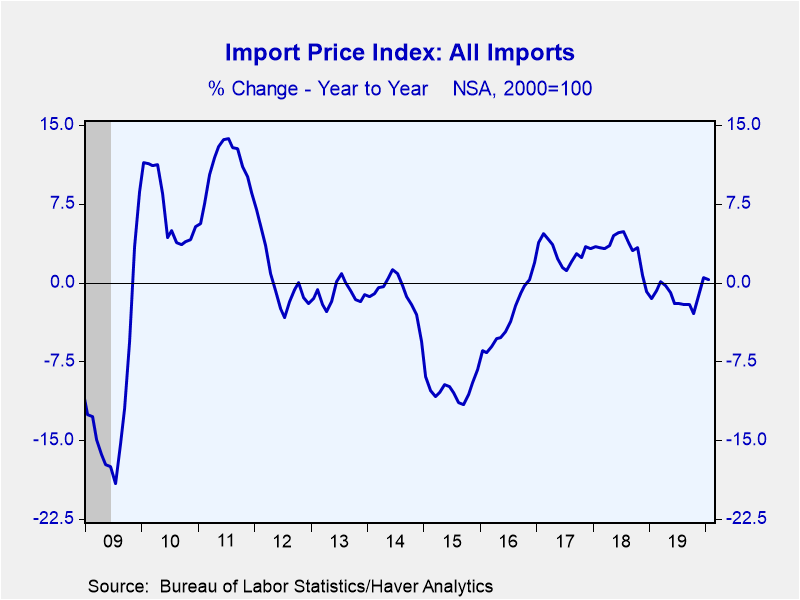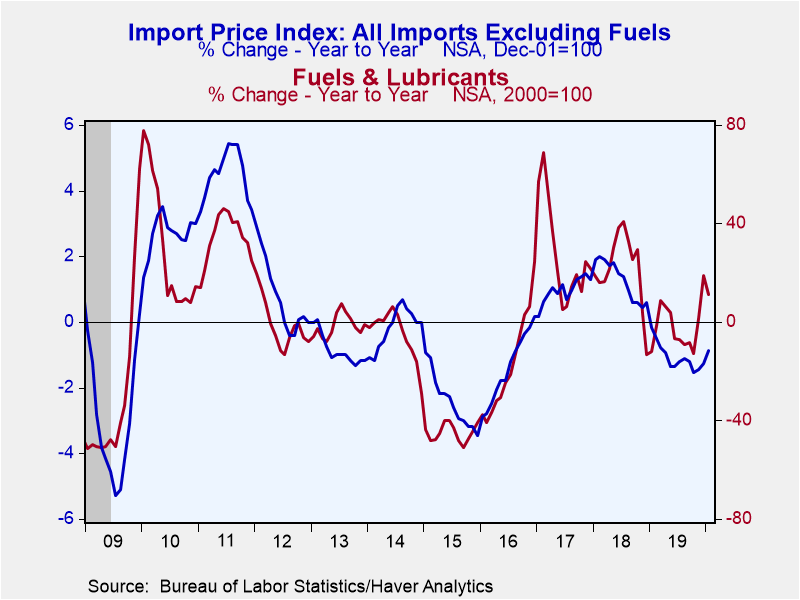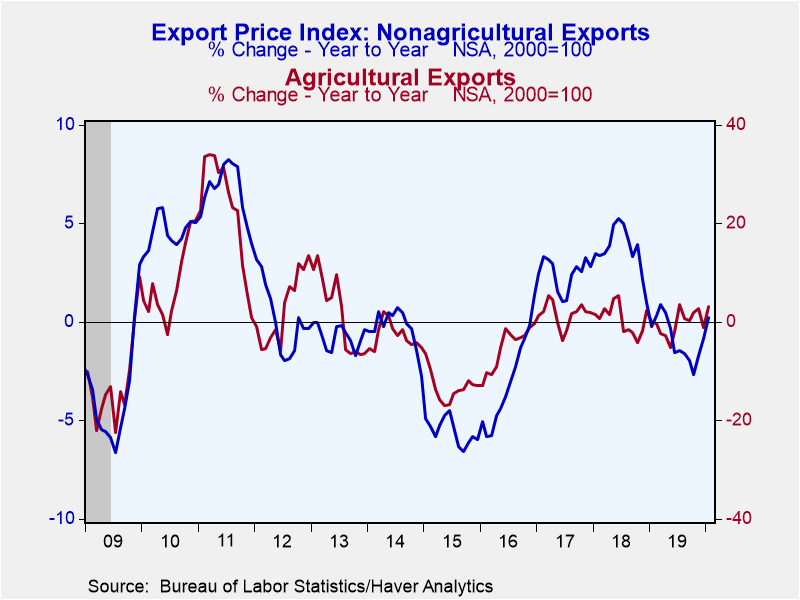 Global| Feb 14 2020
Global| Feb 14 2020U.S. Import Prices Unchanged in January while Export Prices Surge
by:Sandy Batten
|in:Economy in Brief
Summary
• Import prices were unchanged in January as a 2.2% m/m drop in fuel prices offset a modest rise in nonfuel prices. • In contrast, export prices unexpectedly surged 0.7% m/m, the largest monthly increase since last March, led by a [...]
• Import prices were unchanged in January as a 2.2% m/m drop in fuel prices offset a modest rise in nonfuel prices.
• In contrast, export prices unexpectedly surged 0.7% m/m, the largest monthly increase since last March, led by a 2.0% m/m surge in agricultural prices.
Import prices were unchanged in January from December and were up 0.3% from a year earlier. The 0.3% m/m increase initially reported for December was revised down to 0.2%. The Action Economics Forecast Survey had looked for a 0.2% m/m decline in January. These figures are not seasonally adjusted and do not include import duties.
Prices of imported fuel fell 2.2% m/m (+11.3% y/y) in January, offsetting a 0.2% m/m (-0.9% y/y) rise in prices of nonfuel imports. This was only the second monthly increase in nonfuel prices in the past eleven months. Higher prices for finished goods (notably autos, 0.5% m/m)); nonfuel industrial supplies and materials (0.3% m/m); and foods, feeds, and beverages (0.5% m/m) all contributed to the January advance in nonfuel import prices.
Export prices increased 0.7% m/m (0.5% y/y), the largest increase since last March, following an unrevised 0.2% m/m decline in December. Forecasters had expected an unchanged reading for January. Prices of agricultural exports surged 2.0% m/m (3.1% y/y) after having fallen an unrevised 0.1% m/m in December. Rising prices for vegetables, soybeans, wheat, and corn in January more than offset lower prices for fruit, meat, and nuts. Prices of nonagricultural exports rose 0.7% (0.66% at two decimal places) in January and were up just 0.2% from a year ago. This is only the second monthly increase in the past nine months. In January, higher prices for nonagricultural industrial supplies and materials (1.1% m/m); finished goods (of which, autos were up 0.5% m/m); and nonagricultural foods (2.0% m/m) all contributed to the increase in nonagricultural export prices.
The price index for imports from China declined 0.2% m/m in January, after no change in December. The January decline was the largest drop since September; the index has not risen on a monthly basis since May 2018. Prices for exports to China increased 0.3% m/m in January, after having ticked up 0.1% m/m in each of the previous two months, but were down 0.2% from a year earlier.
The import and export price series can be found in Haver's USECON database. Detailed figures are available in the USINT database. The expectations figure from the Action Economics Forecast Survey is in the AS1REPNA database.
| Import/Export Prices (NSA, %) | Jan | Dec | Nov | Jan Y/Y | 2019 | 2018 | 2017 |
|---|---|---|---|---|---|---|---|
| Imports - All Commodities | 0.0 | 0.2 | 0.2 | 0.3 | -1.3 | 3.1 | 2.9 |
| Fuels | -2.2 | 2.6 | 2.4 | 11.3 | -2.1 | 20.8 | 25.6 |
| Nonfuels | 0.2 | 0.2 | -0.1 | -0.9 | -1.1 | 1.3 | 1.0 |
| Exports - All Commodities | 0.7 | -0.2 | 0.1 | 0.5 | -0.8 | 3.4 | 2.4 |
| Agricultural | 2.0 | -0.1 | 2.4 | 3.1 | -0.5 | 0.6 | 1.5 |
| Nonagricultural | 0.7 | -0.2 | -0.1 | 0.2 | -0.9 | 3.7 | 2.5 |
Sandy Batten
AuthorMore in Author Profile »Sandy Batten has more than 30 years of experience analyzing industrial economies and financial markets and a wide range of experience across the financial services sector, government, and academia. Before joining Haver Analytics, Sandy was a Vice President and Senior Economist at Citibank; Senior Credit Market Analyst at CDC Investment Management, Managing Director at Bear Stearns, and Executive Director at JPMorgan. In 2008, Sandy was named the most accurate US forecaster by the National Association for Business Economics. He is a member of the New York Forecasters Club, NABE, and the American Economic Association. Prior to his time in the financial services sector, Sandy was a Research Officer at the Federal Reserve Bank of St. Louis, Senior Staff Economist on the President’s Council of Economic Advisors, Deputy Assistant Secretary for Economic Policy at the US Treasury, and Economist at the International Monetary Fund. Sandy has taught economics at St. Louis University, Denison University, and Muskingun College. He has published numerous peer-reviewed articles in a wide range of academic publications. He has a B.A. in economics from the University of Richmond and a M.A. and Ph.D. in economics from The Ohio State University.










